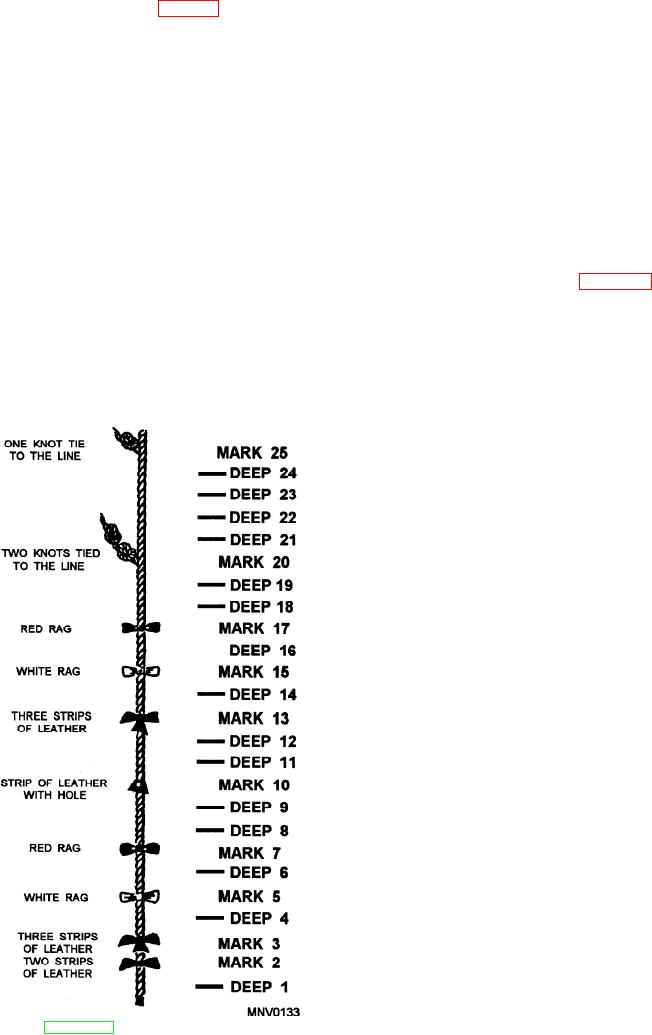
attached to a marked line (fig. 5-9). With the ship
outboard of the chains to gain momentum. When you
making 12 knots, a good leadsman can get reliable
can swing the lead in a complete circle, and the force is
soundings down to 7 fathoms. At slower speeds, of
great enough, let go of the lead as it swings forward at a
course, the lead has time to sink even deeper before the
point about level with the deck
ship moves up to it. The lead line may also be used for
As the ship moves ahead, heave in the spare line
determining the direction in which a ship, practically
rapidly. Read the marker when the lead is on the bottom
dead in the water, is moving. Direction of movement is
and the line hauled just taut, vertically. You will acquire
found by placing the lead on the bottom, directly below
the ability to heave the lead only by practice. It is
the leadsman, and noting the direction of the motion of
necessary to practice with both hands because you will
the ship as shown by the change of direction of the lead
use your right hand for heaving from the starboard chain
line from the vertical.
and your left hand for heaving from the port chain.
Before you heave the lead, take your station in one
A good heave has no value unless you can read the
of the chains, which usually are platforms projecting
depth correctly and quickly. Learn the markings of the
over each side at the after end of the forecastle. The
lead line, which are identified in figure 5-9.
lower the lead over the side and support it in the heaving
hand by a wooden toggle, inserted in the lead line about
Lead lines often are marked at each half-fathom
2 fathoms from the lead. Coil the spare line in your
over the range of depth used most and may even have
other hand, free for running.
foot markings aroundthe more important depths. Some
lead lines are fixed so that you may read the depth at the
To make the heave, start by calling out "Watch-O-
level of the chains instead of at the water's edge. This
Watch," then swing the lead in a fore-and-aft direction
procedure makes it easier to take sounds at night. Learn
any special markings on the lead line that may be used
on your ship.
Report each sounding to the bridge in a sharp, clear
voice. When the sounding agrees with one of the marks,
report it by mark; such as "Mark 2", "Mark 3", or
"Mark 5".
When the sounding falls on an even fathom
between marks, report it as "By the deep 4", "By the
deep 8", "By the deep 9". If the reading does not give an
even fathom, report it as "A quarter less three" (1/4
fathom less than 3 fathoms of water); "And a quarter,
four" (1/4 fathom more than 4 fathoms of water); "And
a half, four" (1/2 fathom more than 4), and so on. If the
lead does not reach the bottom, report "No bottom at
(number of fathoms)".
CANVAS AND LEATHER
Canvas and leather have long been important in a
Seaman's life. In the next few pages, you will learn how
to sew small articles by hand using some of the most
common stitches.
Canvas, often called duck, is a general name for a
class of strong, heavy, plain cloth woven of cotton or
linen. Numbered duck is the canvas encountered most
often, but occasionally you see the terms ounce duck or
army duck. Numbered duck runs from No. 1, the
heaviest, to No. 12, the lightest. Numbers 7, 9, and 11
are no longer issued.
Figure 5-9.--Markings of lead line.
5-6

